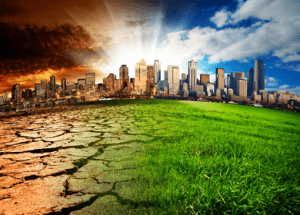
Sustainability is today’s buzzword. But just what is sustainable eating? In ecological terms, sustainability is about how biological systems found in living organisms can remain diverse and productive over time. Thus, a sustainable food system is one that provides people with healthy food to meet current needs, as well as those of generations to come–while maintaining the health of the land, water, plants, animals, humans and natural resources.
 “What you eat is as important to the environment as what you drive. The top three sources of impact on the earth are through your home, transportation and food. Diet is the one single thing that can provide better health for you and the planet, and, unlike a car or home upgrade, you always have to eat sometime in the next few hours,” stresses Kate Geagan, M.S., R.D., dietitian and author of “Go Green Get Lean” (Rodale, 2009).
“What you eat is as important to the environment as what you drive. The top three sources of impact on the earth are through your home, transportation and food. Diet is the one single thing that can provide better health for you and the planet, and, unlike a car or home upgrade, you always have to eat sometime in the next few hours,” stresses Kate Geagan, M.S., R.D., dietitian and author of “Go Green Get Lean” (Rodale, 2009).
So, how do you translate sustainability to the supermarket aisles? Just follow our tips:
SUSTAINABLE SHOPPING GUIDE
1. Trim your food budget. For every ounce of food you cut out (and don’t need), it’s that much less fossil fuel, pesticides, fertilizer and water needed to produce it. Plan your menu in advance, jot down a shopping list and stick to it — no impulse buying.
2. Be picky and stingy about animal proteins. Geagan stresses that meat and seafood are two of the most environmentally taxing foods to bring to your plate. Look for grass-fed red meats, free-range poultry and eco-friendly seafood choices (check out seafoodwatch.org). Trim your animal proteins budget by selecting smaller individual portions, cooking a vegetarian meal at least once a week, and eating more entrees that feature meat as “flavoring,” such as stir fries, casseroles and bean stews, rather than as the main ingredient.
3. Look for nutrient-rich eco bargains. Make the most of your food choices by selecting whole foods that come from “close to the ground” and are packed with nutrients, suggests Geagan. Focus on unprocessed whole grains, beans, fruits and vegetables.
4. Avoid the processed foods trap. The more highly processed the food is — requiring several manufacturing steps and added ingredients shipped in from around the world — the larger its carbon footprint (total greenhouse gases produced), says Geagan. Look for foods with no more than five ingredients and watch out for ingredients that sound like something out of a high school chemistry class.
5. Buy produce in season. Consider the carbon footprint for out-of-season fruit from far-away countries when shopping the produce aisle. Better yet, save your produce shopping for the farmers’ market, where you’ll find local, seasonal produce with a much lower eco-impact.
6. Be smart about organics. Sure, organic production does not allow the use of most synthetic pesticides and fertilizers, making it a more sustainable way to go. But not all organic products are created equal. For example, shipping organic vegetables around the world isn’t exactly the model of sustainability. For that matter, highly processed organic junk foods aren’t either. According to Geagan, the gold standard is local, organic food.
7. Do dairy products right. Dairy products, from milk to cheese, aren’t easy on the environment; these farms are responsible for a hefty chunk of our greenhouse gas emissions. But organic dairy products are a better choice, since synthetic hormones and antibiotics are not used on the animals, and they are fed an organic diet.
8. Sip beverages wisely. Bottled beverages — and their disposable containers — use up lots of fossil fuel in production and transportation, notes Geagan. Try to kick the bottled-beverage habit and opt for tap water and home-brewed coffee and tea.
9. Say no to plastic shopping bags. The average plastic bag is used for 12 minute before heading to a landfill, where it can take up to 1,000 years to break down, says Geagan. Tote your groceries in your own reusable shopping bags.
TURN TO GREENER FOOD PACKAGING
Purchasing foods can be a double whammy: First, the food produces a carbon footprint; then it’s packaged in a container that also has a carbon footprint and contributes to the landfill load. Here are some tips for greener food packaging:
1. Less is better. Avoid double or triple layers of packaging and single-serve items. Shop out of bulk bins for grains, cereals and nuts, and at the farmers’ market for unpackaged produce.
2. Look for recycled or renewable materials. Instead of plastics and polysterene (Styrofoam) made from nonrenewable fossil fuel, look for packages made from recycled or renewable materials, such as paperboard, or composite materials like wood and food starch.
3. Target recyclable or compostable packaging. Pick packages that are biodegradable or can be recycled (the best is “closed loop,” meaning it is recycled into the same product it came from, such as a glass bottle).
4. Choose non-rigid over rigid. Non-rigid packaging, such as paper wrapping, is lighter to transport and takes up less space in a landfill than rigid packaging like hard clamshell plastics and cups.
– Sharon Palmer R.D.
As a registered dietitian with 16 years of health care experience, she focuses on writing features covering health, wellness, nutrition, cooking, wine, restaurant reviews, and entertainment. Over 750 of Sharon’s features have been published in a variety of publications. Her recent book The Plant-Powered Diet: The Lifelong Eating Plan for Achieving Optimal Health, Beginning Today can be ordered here.

